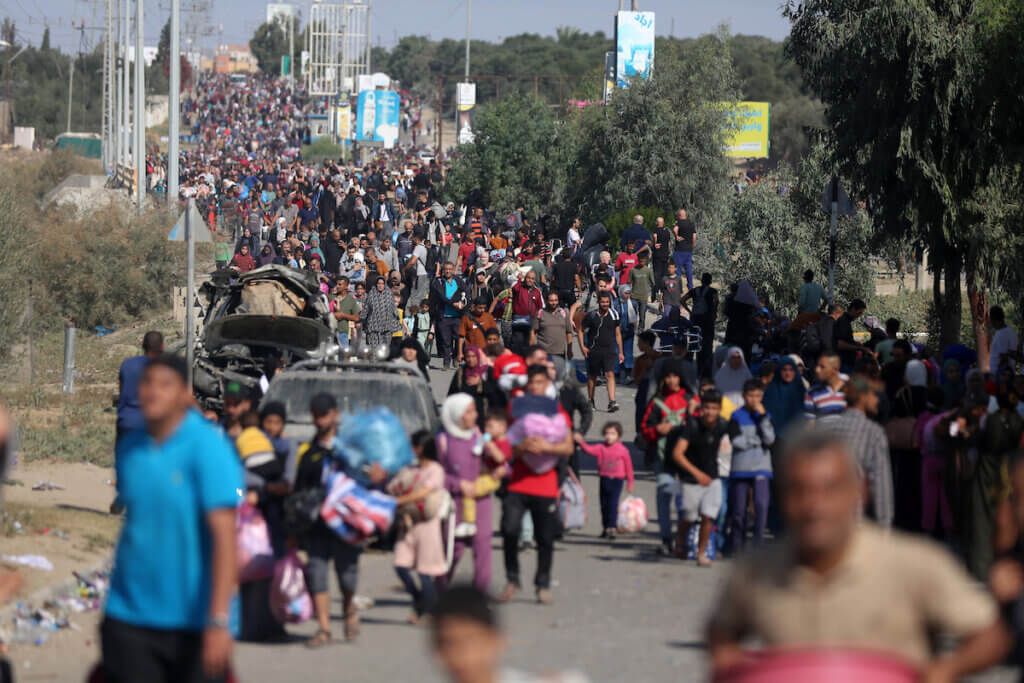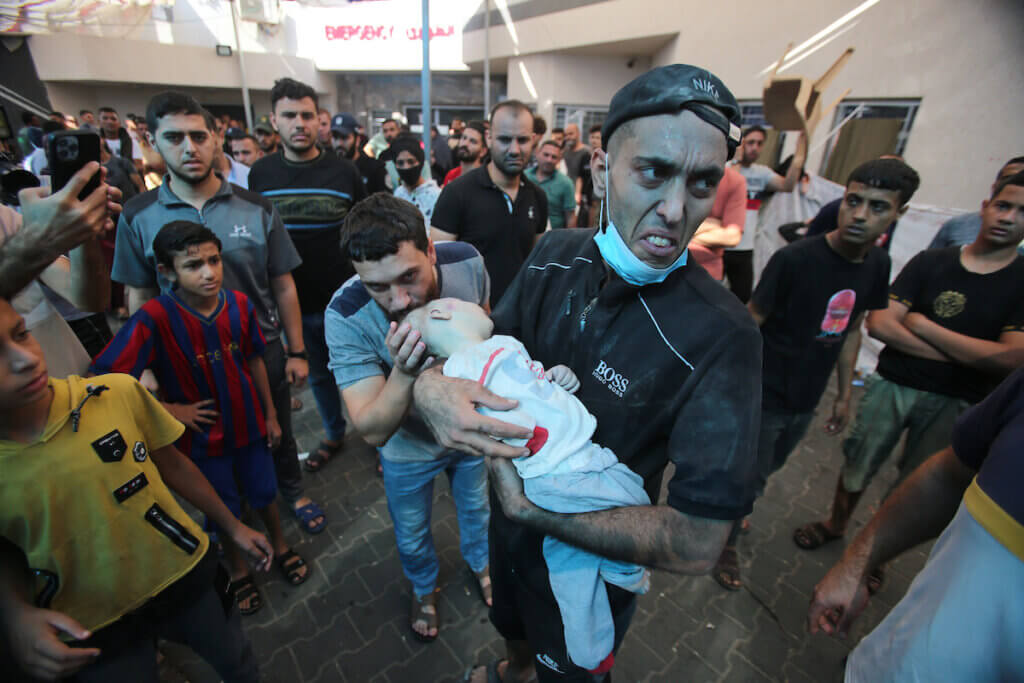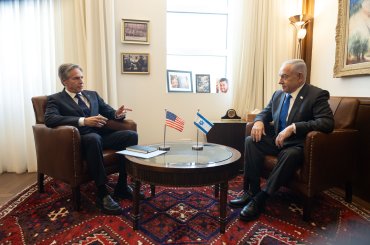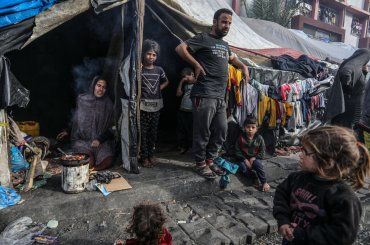Casualties
- 11,078 killed*, including 4,506 children, and 27,490 wounded in Gaza
- 183 Palestinians killed* in the occupied West Bank and East Jerusalem
- Israel revises its estimated October 7 death toll down from 1,400 to 1,200
Key Developments
- Al-Shifa hospital in Gaza City, in which thousands of Palestinians have sought refuge, is now considered a “combat zone” by Israel and has been under fire for nearly two days
- The confrontations between Palestinian resistance groups and Israeli forces in Gaza City have been the most intense since the beginning of Israel’s ground offensive
- Some 30,000 people fled northern Gaza on Friday, only for a strike to hit the supposed humanitarian corridor, killing dozens
- Saudi Arabia hosts a summit in Riyadh regarding Gaza, with Iranian President Ebrahim Raisi in attendance
- Columbia University becomes second U.S. university to ban suspend local chapter of Students for Justice in Palestine, as well as Jewish Voice for Peace
- Israel revises its estimated October 7 death toll down from 1,400 to 1,200
- Israel’s state prosecutor releases data showing eight Israelis have been arrested for racist violence against Palestinians since October 7. By contrast, more than 2,300 Palestinians have been detained from the occupied West Bank during the same period of time, most of them without charges, while Palestinian citizens of Israel have been investigated for posting on social media
- For a list of protests happening around the world this weekend, click here.
Al-Shifa hospital under fire
Al-Shifa Medical Center in Gaza City, the biggest hospital in the besieged Gaza Strip, has been surrounded by Israeli forces since Friday, finding itself trapped at the center of what has been described as the most intense fighting between Palestinian armed resistance groups and Israeli ground forces since the beginning of Israel’s onslaught on Gaza.
The Gaza Ministry of Health reported on Friday night that Israeli forces were bombing in the vicinity of al-Shifa with such intensity that ambulances could not exit or leave the complex. Eyewitnesses also reported over social media that no one could leave the area without being targeted by Israeli drones or snipers. Strikes near and on the premises of the hospital were still ongoing on Saturday afternoon.
“We renew our call to all international institutions to come immediately to the Al-Shifa Medical Complex and the hospitals in northern Gaza to protect the health system and enable it to carry out its purely humanitarian tasks,” ministry spokesman Ashraf al-Qidra wrote.
A number of shells landed in the hospital yard, WAFA news agency reported.
At least three other hospitals in northern Gaza and Gaza City have been encircled by Israeli forces and tanks since Friday, in what one doctor told Al Jazeera was a “day of war against hospitals.” At least one, the Indonesian Hospital, reportedly completely lost power — leading the U.N. Office for the Coordination of Humanitarian Affairs (OCHA) to raise its tally to 20 out 36 hospitals in Gaza no longer functioning.
Israel has repeatedly claimed al-Shifa, which has been directly hit at least half a dozen times since Thursday night, sits above Hamas’s main command center in Gaza — claims of which there is no evidence and that Hamas denies. What is undisputed, however, is that the hospital is currently a refuge for thousands of civilians seeking shelter and medical treatment amid the absolute devastation caused by Israeli bombs raining over Gaza since October 7.
Despite Israel’s repeated claims about al-Shifa’s Hamas ties, and its undisputed encircling of hospitals in recent days, Israeli army spokesman Avichay Adraee made the implausible claim that al-Shifa was hit by a misfired Palestinian rocket — echoing Israel’s claims regarding the deadly strike on al-Ahli hospital on October 17.
The Gaza Ministry of Health has stated that al-Shifa has lost its capacity to treat patients as it has run out of fuel. Israeli military sources meanwhile told Haaretz that they had contacted the director of al-Shifa hospital and told him the hospital was now considered to be in a “combat zone” and that all patients must be evacuated. The Gaza Health Ministry has said that 39 babies in incubators and countless other patients in critical condition in the hospital are currently at imminent risk of death due to lack of access to treatment, and many are in no condition after over a month of war, dehydration, and hunger, to walk towards southern Gaza.

Palestinians fleeing northern Gaza killed by strike
Amid the targeting of northern Gaza’s remaining medical centers, which have hosted tens of thousands of Palestinians hoping for shelter from Israeli bombings, Israeli airstrikes across northern Gaza killed at least 13 people and wounded dozens in Nuseirat refugee camp and Beit Lahia, WAFA reported.
The past few days have also witnessed tens of thousands of Palestinians heading to southern Gaza on foot during Israel’s “tactical pauses,” a sight many have compared to the 1948 Nakba that saw 750,000 Palestinians flee their homes. Some 70% of Gaza inhabitants are refugees who were directly forcibly displaced or descendants of those displaced during the Nakba.
While Israel has repeatedly claimed that Palestinians should evacuate to southern Gaza to escape its airstrikes, this has been repeatedly proven false over the past month as Israeli strikes have hit southern Gaza and many supposedly neutral safe zones where civilians take refuge.
On Friday, an Israeli strike reportedly killed dozens of Palestinians who were walking on Salah al-Din Street, the supposedly safe corridor leading them south.
OCHA said more than 30,000 Palestinians evacuated from the north on Friday alone, adding to the more than 1.5 million of Gaza’s 2.3 million inhabitants who are internally displaced by the war. One person who spoke to OCHA said the journey south was “terrifying,” with soldiers detaining people along the way and forcing others to leave some of their meager belongings behind.
OCHA has repeatedly stated that the number of people taking refuge in UNRWA shelters was exceeding capacity ninefold — with an average of one toilet per 160 people and one shower per 700 people, leading Haaretz’s Amira Haas to conclude that Palestinians in Gaza were forced to “choose between Israeli bombardment and disease.”
During the latest U.N. Security Council meeting regarding the situation in Gaza on Friday, World Health Organization (WHO) head Tedros Adhanom Ghebreyesus called for a ceasefire, an increase in the amount of aid allowed into Gaza. “In Gaza, nowhere and no one is safe,” he said.
West Bank detentions continue
Tensions remained high in the occupied West Bank, where Israeli forces detained at least 25 Palestinians overnight. At least three Palestinians were reported to have been shot and injured by Israeli forces in Yabad, Yatta and Tulkarem.
Nearly 2,500 Palestinians have been detained in the occupied West Bank and East Jerusalem in slightly over a month, many of them without charges. Palestinian prisoners’ rights group Addameer estimates that at least 7,000 Palestinians are currently imprisoned by Israel
Earlier this week, Amnesty International denounced the “horrifying” torture and mistreatment Israeli authorities have inflicted upon Palestinian detainees since October 7. “Over the last month we have witnessed a significant spike in Israel’s use of administrative detention – detention without charge or trial that can be renewed indefinitely – which was already at a 20-year high before the latest escalation in hostilities on 7 October,” Heba Morayef, Amnesty’s regional director for the Middle East and North Africa, said. “Testimonies and video evidence also point to numerous incidents of torture and other ill-treatment by Israeli forces including severe beatings and deliberate humiliation of Palestinians who are detained in dire conditions.”
Armed confrontations between Palestinian resistance groups and Israeli forces were reported overnight in Nablus, Ramallah, Qalqiliya, Silat al-Harithiya, Silat al-Dhaher, and near the illegal Israeli settlement of Beit El.
In the northern West Bank, Jenin has been the site of particularly intense fighting since October. Doctors Without Borders (MSF) called on Friday for Israeli forces to stop attacks on medical care in Jenin refugee camp, noting that soldiers had fired shots at the local hospital’s emergency unit, as well as prevented ambulances from accessing hospitals.
OCHA meanwhile reported that 51 Palestinians belonging to a herding community in the Hebron governorate were forcibly displaced on Friday after ongoing violence and threats by Israeli settlers. At least 1,149 Palestinians have been displaced in the West Bank since October 7 — as Peace Now has described settler violence against Palestinians in the occupied territory as the “third front” of the war.
Israeli strikes hit further north into Lebanon front
Further north, tensions have also escalated, as resistance groups in Lebanon hit a number of locations in northern Israel, with at least four Israeli soldiers seriously wounded by an anti-tank missile. Lebanon’s Hezbollah movement has meanwhile reported the deaths of seven of its fighters in the past 24 hours.
Meanwhile, Israeli strikes into southern Lebanon have extended further north than at any previous point in the past few weeks, with one missile hitting Zahrani, more than 40 kilometers north of the Blue Line, Lebanese media reported.
Hezbollah leader Hassan Nasrallah is set to speak on Saturday afternoon, his second allocution since the beginning of Operation Al-Aqsa Flood. His first, long-awaited speech two weeks ago was largely interpreted as seeking to avoid a more significant escalation of conflict in Lebanon, while touting the Lebanese group’s ability to confront Israel further if need be. The killing of a grandmother and her three granddaughters in an Israeli strike in southern Lebanon earlier this week may change the equation for Hezbollah.
Facing a devastating economic crisis and political vacuum since 2019, many in Lebanon are wary of adding an all-out war with Israel to the list of their woes.
Saudi Arabia hosts regional summit
Saudi Arabia was hosting an Arab and Islamic summit for Gaza on Saturday, attended by a number of regional leaders, including Iranian President Ebrahim Raisi.
“This is a humanitarian catastrophe that has proved the failure of the international community and the UN Security Council to put an end to Israel’s gross violations of international humanitarian laws, and prove the dual standards adopted by the world,” Crown Prince Mohammed bin Salman said in his opening remarks. “We are certain the only cause for peace is the end of the Israeli occupation and illegal settlements, and restoration of the established rights of the Palestinian people and the establishment of the state on 1967 [borders], with East Jerusalem as its capital.”
Palestinian Authority President Mahmoud Abbas — already deeply unpopular among Palestinians before October 7 due to the PA’s security coordination with Israel — was also in attendance, stating: “Gaza is an integral part of the State of Palestine, and any political solution must encompass the entire Palestinian territory, including the West Bank, Jerusalem, and Gaza.”
Raisi, whose presence in Riyadh marked a notable turning point in the warming relationship between Saudi Arabia and Iran, said: “Gaza is not an arena for words. It should be for action.”
“Today, the unity of the Islamic countries is very important,” he added. Iran is one of the main backers of both Hamas in Palestine and Hezbollah in Lebanon.
Elsewhere, a number of government officials from the Global North have expressed belated, but growing, concern for Palestinians in Gaza.
While Washington had previously said it would not draw any “red lines” for Israel, U.S. Secretary of State Antony Blinken said on Friday that “far too many Palestinians have been killed.” French President Emmanuel Macron, who hosted a summit on Gaza aid earlier this week that received mixed reviews, told the BBC on Friday that while he called for an end to the killing of women and babies, he thought “it would not be the right way to deal with a partner and a friend [Israel], to say: ‘You will be condemned and you’re guilty.’ I’m not a judge. I’m a head of state. I just remind everybody of international law. I call for the ceasefire.”
Belgian Prime Minister Alexander De Croo, meanwhile, called Israel’s bombardment of Gaza “disproportionate”, a few days after Belgium’s deputy prime minister called for sanctions against Israel.
Scores of pro-Palestine protests are set to take place across the world this weekend — including in the U.K., where Home Secretary Suella Braverman had called for a London demonstration to be canceled, calling recent, overwhelming peaceful gatherings “hate marches.”
Notes
* The Palestinian Ministry of Health has not announced updated casualty statistics for November 11, 2023. This story will be updated once it does.



On the Lebanon front Amnesty claims that white phosphorus has been used –
“Lebanon: Evidence of Israel’s unlawful use of white phosphorus in southern Lebanon as cross-border hostilities escalate”
https://www.amnesty.org/en/latest/news/2023/10/lebanon-evidence-of-israels-unlawful-use-of-white-phosphorus-in-southern-lebanon-as-cross-border-hostilities-escalate/
With regards to the Sheikh Hamad bin Khalifa Hospital for Rehabilitation and Prosthetic Hospital, a feature that the IDF claimed was a Hamas tunnel turned out to be a water storage tank, I think the evidence for that is indisputable:
“Investigation disproves Israel claim of Hamas tunnel under Gaza hospital…The hatch Israel claimed was a Hamas tunnel is only a water reservoir for the hospital.”
https://www.aljazeera.com/news/2023/11/8/investigation-disproves-israel-claim-of-hamas-tunnel-under-gaza-hospital
There are reports that many doctors have been killed in Gaza hospitals and many international health care workers … nurses and others, who are trapped in Gaza and can’t get out. They are pleading for help … its an emergency situation for them. They are afraid of being killed from the Israeli bombing and they want to get out ASAP. Its a DIRE situation for them!